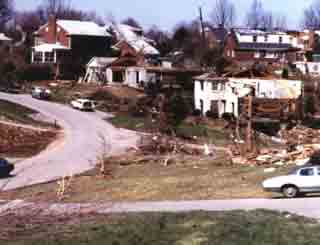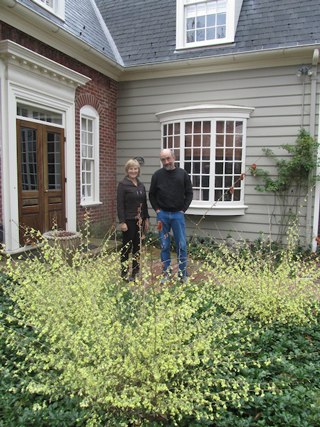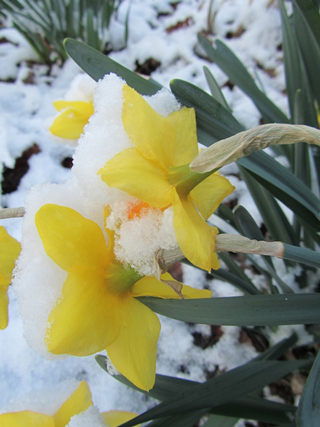Human Flower Project
Weird Weather
The onset of spring is a menace and a blessing. Allen Bush hunts for flowers amid the extremes.

The view down Pennington Lane, Louisville, KY,
in the author’s old neighborhood, April 3, 1974
Photo: Walter McCord
from Tornado: A Look Back at Louisville’s Dark Day
By Allen Bush
I like to think the worst weather is over by March but it doesn’t work that way. There are more surprises in store in April. When the winds begin to rattle the window jambs at this time of year I get the heebie jeebies. It means it’s tornado season in Kentucky. For a long time I thought Lenten twisters were meant for trailer parks. I grew-up imagining that my suburban neighborhood of solid brick homes made us more virtuous, and immune.
That changed on April 3, 1974. I was a few hundred yards from the path of a Louisville tornado, holed-up in a friend’s basement. It hop-scotched across the Fairgrounds, the Highlands, Cherokee Park, Crescent Hill, Rolling Fields and Indian Hills before bouncing over to Northfields. I’ll huff and I’ll puff and I’ll blow your brick houses down. And the big bad wolf did.
The physical destruction was indelible: huge trees snapped in half and homes destroyed. The National Guard secured damaged neighborhoods for a couple of weeks while debris was cleared from roadways, and power was restored slowly over the next six weeks. Neighbors pitched-in, picking-up and hacking away. By summer, this moment of neighborly clarity receded when everyone – well, at least those with standing houses—returned to the shut-in privacy of their air-conditioned homes. Suburban detachment resumed.
 Rose Cooper Bush and visiting friend Charles Murray, of Asheville, with the spike winterhazel (Corylopsis spicata), Top Hill Road.
Rose Cooper Bush and visiting friend Charles Murray, of Asheville, with the spike winterhazel (Corylopsis spicata), Top Hill Road.
Photo: Allen Bush
Louisville’s Cherokee Park is still dealing with the aftermath nearly forty years later. The forest canopy – in large sections—had been stripped bare, exposing it to the opportunistic bush honeysuckle Lonicera maackii that took over. A nasty invader if there ever was one, it leafs out when the forsythias come into bloom and shades-out all comers. No spring ephemeral wildflower stands a chance. There’s no way an oak or maple seedling could penetrate the shadowy darkness of a grove of bush honeysuckles.
The Olmsted Parks Conservancy, only in the last few years, has been trying to reverse the tide – and is winning this round. It will require yearly vigilance since the plentiful honeysuckles adjacent to the park will continue to provide ample seed stock for years to come. (I weed-out seedlings in our garden every week from March through October.)
I fled Kentucky’s weather extremes for fifteen years in the late seventies, but weather wickedness caught-up with me. I moved to the North Carolina Mountains to start Holbrook Farm and Nursery. The weather was – on average – cooler in the summers and warmer in the winters—altogether better for plant growth. (I didn’t figure on gumbo clay soils.) A visiting group of North Carolina ornamental plant growers came around about eight years into this experiment and, by then, I’d had a taste of the possibilities.
In the span since my arrival, as I explained to the professionals, Fletcher, North Carolina, had experienced the coldest temperatures on record, one of the driest summers, a mid-March blizzard and a record late freeze in early May. A slow-talking fellow, wearing a ball cap and working a thick wad of chewing tobacco, raised his hand and offered a comment with an accent as thick as sorghum. “Before you moved here, everything was ok.” I protested and said I hadn’t brought any tornadoes. The nurseryman seemed sure a funnel cloud would drop from the heavens.
 The Christmas rose, Helleborus niger ssp. praecox, Yew Dell Gardens, Crestwood, KY, 3/18/11
The Christmas rose, Helleborus niger ssp. praecox, Yew Dell Gardens, Crestwood, KY, 3/18/11
Photo: Allen Bush
This year in Kentucky, early witch hazel blooms were held back by chilly February temperatures but jumped at the chance of longer days and a little warmth in early March. The fat white saucers on the Christmas rose Helleborus niger waited until Mardi Gras before opening. Soon they were met by yellows, purples, pinks and spotted blooms on the Lenten roses Helleborus x orientalis. My Jelitto colleague Mary Vaananen and I took a field trip to Yew Dell in Crestwood, KY, on March 18th and saw hundreds of beautiful hellebores of all sorts.
The Ohio River had flowed out of its banks and crested earlier that week. There had been a fair amount of rain but not bucket loads in the lower Ohio Valley. Most of the floodwater came from snowmelt in western Pennsylvania, and the swollen river caught up with Louisville. I live high on a hill, well above Beargrass Creek that flows into the Ohio. High water won’t get me. The ground was saturated and the sky turned a miserable thick, ashen gray. I would have felt worse if this had been February but I knew April was around the corner. My granddaughter and I wandered around the garden and I pointed-out snowdrops, a few Crocus and the early flowering daffodil Narcissus ‘Little Beauty’. She wasn’t interested in the rare Asian Adonis amurensis in the part shade near some hellebores by the street. She had better things to do, grabbed a trowel and filled the birdbath with pea gravel.
I’m living on borrowed time with Prunus mume —a favorite cherry of J.C. Raulston’s that is completely do-able in Raleigh, NC. I never expected the Japanese Apricot would make it in Louisville. The white flowering cultivar ‘Rosemary Clarke’ has grown bigger the last five years and has survived a string of mild winters (though it doesn’t seem right to call any winter “mild” when skies are gray for months on end). Even if we don’t get whacked some winter with -10 F (-23 C), the tree will be soon be overgrown by a nearby swamp white oak.
 Narcissus in the snow, 3/27/11, Top Hill, Louisville, KY
Narcissus in the snow, 3/27/11, Top Hill, Louisville, KY
Photo: Allen Bush
There was no damaging frost for over three weeks this March. Odder still were summer-like temperatures in the low 80s (27 C)—hotter than the average 60 F (16 C) on the first days of spring—followed by snow four days later, March 27th. The Scillas, daffodils and Tulipa turkestanica didn’t flinch with this huge temperature swing. Somehow, the frost sensitive flowers on Magnolia ‘Wada’s Memory’ didn’t get toasted. I love these white flowers that look like handkerchief parachutes. This makes three years in a row – if our luck holds – that other saucer and star Japanese Magnolias around town have remained untouched by a sneaky frost. The dusting of snow didn’t bother them a bit.
I don’t know if strange weather is any more commonplace now than ever. Lots of people say so. I haven’t kept track but there always seems to be a little too much excitement. I am grateful whenever we dodge the worst of it and feel so sorry when others aren’t so lucky. The misery in Japan continues to cloud my spring. The property damage looks overwhelming; the threat of radiation so frightening and the grief unending. But I pray there will be a turning point and I hope it will come, in some small way, with flowers. I feel the blessings of Kentucky gardens.
Comments
Thanks, Panayoti. The winds were blowing hard all last night and the skies were dark and ominous this afternoon, but it’s quiet now. Thank goodness! Rose and I were in the woods yesterday and enjoyed the spring beauties, meadow rues and dog tooth violets. Masses of leafy ramps.The bloodroots and twinleafs have gone by. Trilliums coming on strong. Plan on a trip to Kentucky next April (2nd or 3rd week) and we’ll hit the mountains, too.
Allen: Spotted my first hellebores, with friends, two weekends ago. Local parks are full of magnolia blossoms (will post for Garden Bloggers Bloom Day) and cherries, too. And the Callery pears are blooming but not as brilliantly as last year.
(The news about Japan continues to be sobering.)


Enjoyed your essay: tornados are a bane of ours as well in Colorado. Fortunately, our’s tend to be skinny. What a spectacular Christmas rose: ours were a bit scrunchy this year due to extreme cold winter and dry spring.
An Appalachian spring must be the closest thing to Heaven on earth!